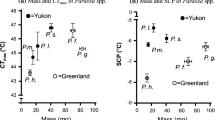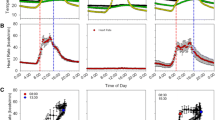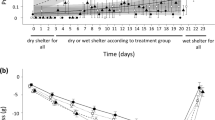Abstract
Woolly dormice, Dryomys laniger Felten and Storch (Senckenbergiana Biol 49(6):429–435, 1968), are a small (20–30 g), omnivorous (mainly insectivorous), nocturnal glirid species endemic to Turkey. Although woolly dormice have been assumed to hibernate during winter, no information exists on body temperature patterns and use of torpor in the species. In the present study, we aimed to determine body temperature patterns and use of torpor in woolly dormice under controlled laboratory conditions. Accordingly, body temperature (Tb) of woolly dormice was recorded using surgically implanted Thermochron iButtons, small and inexpensive temperature-sensitive data loggers. Woolly dormice exhibited robust, unimodal daily Tb rhythmicity during the euthermic stage before the beginning of hibernation. They displayed short torpor before they began hibernation, although the tendency to enter short torpor was different among individuals. Woolly dormice began hibernation within 1–3 days after exposure to cold and darkness, i.e., on October 22–24, and ended hibernation in the first half of April. Hibernation consisted of a sequence of multiday torpor bouts, interrupted by euthermic intervals. Thus, the patterns of hibernation in woolly dormice were similar to those observed in classical hibernating mammals.






Similar content being viewed by others
References
Bennett AF, Ruben JA (1979) Endothermy and activity in vertebrates. Science 206:649–654
Bieber C, Ruf T (2009) Summer dormancy in edible dormice (Glis glis) without energetic constraints. Naturwissenschaften 96(1):165–171
Cranford JA (1978) Hibernation in the western jumping mouse (Zapus princeps). J Mamm 59(3):496–509
Daan S, Aschoff J (2001) The entrainment of circadian systems. In: Takahashi JS, Turek FW, Moore RY (eds) Handbook of behavioral neurobiology, vol 12. Circadian Clocks, Kluwer Academic/Plenum, New York, pp 7–43
Felten H, Storch G (1968) Eine neue Schläfer-Art Dryomys laniger n. sp. aus Kleinasien (Rodentia: Gliridae). Senckenbergiana Biol 49(6):429–435
Felten H, Spitzenberger F, Storch G (1973) Zur Kleinsäugerfauna West-Anatoliens. Teil II. Senckenbergiana Biol 54:227–290
Florant GL, Fenn AM, Healy JE, Wilkerson GK, Handa RJ (2010) To eat or not to eat: the effect of AICAR on food intake regulation in yellow-bellied marmots (Marmota flaviventris). J Exp Biol 213:2031–2037
Fluxman S, Haim A (1993) Daily rhythms of body temperature in Acomys russatus: the response to chemical signals released by Acomys cahirinus. Chronobiol Int 10(3):159–164
Fowler PA, Racey PA (1990) Daily and seasonal cycles of body temperature and aspects of heterothermy in the hedgehog, Erinaceus europaeus. J Comp Physiol B 160(3):299–307
French AR (1985) Allometries of the durations of torpid and euthermic intervals during mammalian hibernation: a test of theory of metabolic control of the timing of changes in body temperature. J Comp Physiol B 156:13–19
French AR (1988) Patterns of mammalian hibernation. Am Sci 76:569–575
Geiser F, Baudinette B (1988) Daily torpor and thermoregulation in the small dasyurid marsupials Planigale gilesi and Ningaui yvonneae. Aust J Zool 36:473–481
Geiser F, Kenagy GJ (1988) Torpor duration in relation to temperature and metabolism in hibernating ground squirrels. Physiol Zool 61(5):442–449
Geiser F, Ruf T (1995) Hibernation versus daily torpor in mammals and birds: physiological variables and classification of torpor patterns. Physiol Zool 68:935–966
Geiser F (2001) Hibernation: endotherms. In “Encyclopedia of life sciences”, Macmillian, Nature Publishing Group, New York, pp 1–8
Grahn DA, Miller JD, Houng VS, Heler HC (1994) Persistence of circadian rhythmicity in hibernating ground squirrels. Am J Physiol 266(35):R1251–1258
Haim A, Van Aarde RJ, Zisapel N (1997) Body temperature daily rhythms in the striped Mouse Rhabdomys pumilio: the effects of α and α Blocade. Physiol Behav 63(5):889–893
Heldmaier G, Ruf T (1992) Body temperature and metabolic rate during natural hypothermia in endotherms. J Comp Physiol B 162(8):696–706
Heller HC, Poulson TL (1970) Circadian rhythms-II. Endogenous and exogenous factors controlling reproduction and hibernation in chipmunks (Eutamias) and ground squirrels (Spermophilus). Comp Biochem Physiol 33:357–383
Heller HC, Colliver GW (1974) CNS regulation of body temperature during hibernation. Am J Physiol 227(3):583–589
Humphries MM, Thomas DW, Kramer DL (2001) Torpor and digestion in food-storing hibernators. Physiol Biochem Zool 74(2):283–292
Hut RA, Barnes BM, Daan S (2002) Body temperature patterns before, during, and after semi-natural hibernation in the European ground squirrel. J Comp Physiol B 172:47–58
Institute for Laboratory Animal Research-ILAR (2011) Guide for the care and use of laboratory animals, 8th edn. The National Academies, Washington, DC
IUCN (2008) The IUCN red list of threatened species. IUCN, Cambridge
Jansky L, Vanecek J, Hanzal V (1989) Absence of circadian rhythmicity during hibernation. In: Malan A, Canguilhem B (eds) Living in the cold. INSERM/Libby, Paris, pp 34–38
Kart Gür M (2008) Hibernation pattern of Anatolian ground squirrel (Spermophilus xanthoprymnus). Hacettepe University, Dissertation
Kart Gür M, Refinetti R, Gür H (2009) Daily rhythmicity and hibernation in the Anatolian ground squirrel under natural and laboratory conditions. J Comp Physiol B 179(2):155–164
Keckler MS, Gallardo-Romero NF, Langham GL, Damon IK, Karem KL, Carroll DS (2010) Physiologic reference ranges for captive black-tailed prairie dogs (Cynomys ludovicianus). J Am Assoc Lab Anim Sci 49(3):274–281
Kıvanç E, Sözen M, Çolak E, Yiğit N (1997) Karyological and phallic characteristics of Dryomys laniger Felten and Storch, 1968 (Rodentia: Gliridae) in Turkey. Israel J Zool 43:401–403
Kobbe S, Ganzhorn JU, Dausmann KH (2011) Extreme individual flexibility of heterothermy in freeranging Malagasy mouse lemurs (Microcebus griseorufus). J Comp Physiol B 181(1):165–173
Körtner G, Song X, Geiser F (1998) Rhythmicity of torpor in a marsupial hibernator, the mountain pygmy-possum (Burramys parvus), under natural and laboratory conditions. J Comp Physiol B 168:631–638
Körtner G, Geiser F (2000) The temporal organization of daily torpor and hibernation: circadian and circannual rhythms. Chronobiol Int 17(2):103–128
Kryštufek B, Vohralík V (2005) Mammals of Turkey and Cyprus Rodentia I: Sciuridae, Dipodidae, Gliridae. Arvicolinea. Kniznica Annales Majora, Koper, Slovenia
Krzanowski A (1961) Weight dynamics of bats wintering in a cave at Pulawy (Poland). Acta Theriol 4:242–264
Lovegrove BG (2000) Daily heterothermy in mammals: coping with unpredictable environments. In: Heldmaier G, Klingenspor M (eds) Life in the Cold: 11th International Hibernation Symposium. Springer, Berlin, pp 29–40
Lovegrove BG (2009) Modification and miniaturization of Thermochron iButtons for surgical implantation into small animals. J Comp Physiol B 179(4):451–458
Lyman CP, Willis JS, Malan A, Wang LCH (1982) Hibernation and torpor in mammals and birds. Academic, New York
McKechnie AE, Mzilikazi N (2011) Heterothermy in Afrotropical mammals and birds: a review. Integr Comp Biol 51(3):349–363
Menaker M (1961) The free running period of the bat clock; seasonal variations at low body temperature. J Cell Comp Physiol 57(2):81–86
Michener GR (1992) Sexual differences in over-winter torpor patterns of Richardson’s ground squirrels in natural hibernacula. Oecologia 89:397–406
Mrosovsky N (1971) Hibernation and the hypothalamus. Appleton-Century-Crofts, New York
Mumm B, Kaul R, Heldmaier G, Schmidt I (1989) Endogenous 24-hour cycle of core temperature and oxygen consumption in week-old Zucker rat pups. J Comp Physiol B 159:569–575
Mursaloğlu B (1973) Türkiye’nin Yabani Memelileri. TUBITAK IV. Bilim Kongresi Tebliğ Özetleri, 1–10
Mzilikazi N, Madikiza Z, Oelkrug R, Baxter RM (2012) Hibernation in free-ranging African woodland dormice, Graphiurus murinus. In: Ruf T, Bieber C, Arnold W, Millesi E (eds) Living in a seasonal world, Thermoregulatory and Metabolic Adaptations. Springer, Berlin, pp 41–50
Nelson W, Tong YL, Lee JK, Halberg F (1979) Methods for cosinor rhythmometry. Chronobiologia 6(4):305–323
Oklejewicz M, Daan S, Strijkstra AM (2001) Temporal organization of hibernation in wild-type and tau mutant Syrian hamsters. J Comp Physiol B 171:431–439
Pengelley ET, Fisher KC (1961) Rhythmical arousal from hibernation in Golden-mantled ground squirrel, Citellus lateralis tescorum. Can J Zool 39:105–120
Piccione G, Caola G, Refinetti R (2002) The circadian rhythm of body temperature of the horse. Biol Rhythm Res 33:113–119
Pretzlaff I, Dausmann KH (2012) Impact of climatic variation on the hibernation physiology of Muscardinus avellanarius. In: Ruf T, Bieber C, Arnold W, Millesi E (eds) Living in a seasonal world: thermoregulatory and metabolic adaptations. Springer, Berlin, pp 85–97
Refinetti R, Menaker M (1992) The circadian rhythm of body temperature. Physiol Behav 51:613–637
Refinetti R (1996) Comparison of the body temperature rhythms of diurnal and nocturnal rodents. J Exp Zool 275(1):67–70
Refinetti R (1998) Homeostatic and circadian control of body temperature in the fat-tailed gerbil. Comp Biochem Physiol A Mol Integr Physiol 119(1):295–300
Refinetti R (1999) Relationships between the daily rhythms of locomotor activity and body temperature in eight mammalian species. Am J Physiol 277:R1493–1500
Refinetti R (2004) Non-stationary time series and robustness of circadian rhythms. J Theor Biol 227:571–581
Refinetti R, Cornélissen G, Halberg F (2007) Procedures for numerical analysis of circadian rhythms. Biol Rhythm Res 38:275–325
Revel FG, Herwig A, Garidou ML, Dardente H, Menet JS, Pévet MM, Simonneaux V, Saboureau M, Pevet P (2007) The circadian clock stops ticking during deep hibernation in the European hamster. PNAS 104(34):13816–13820
Rojas AD, Körtner G, Geiser F (2010) Do implanted transmitters affect maximum running speed of two small marsupials? J Mamm 91:1360–1364
Ruby NF, Dark J, Burns DE, Heller HC, Zucker I (2002) The suprachiasmatic nucleus is essential for circadian body temperature rhythms in hibernating ground squirrels. J Neurosci 22(1):357–364
Ruby NF (2003) Hibernation: when good clocks go cold. J Biol Rhythm 18(4):275–286
Ruf T (1999) The Lomb-Scargle periodogram in biological rhythm research. Analysis of incomplete and unequally spaced time-series. Biol Rhythm Res 30:178–201
Russell RL, O’Neill PH, Epperson LE, Martin SL (2010) Extensive use of torpor in 13-lined ground squirrels in the fall prior to cold exposure. J Comp Physiol B 180(8):1165–1172
Scott GW, Fisher KC, Love JA (1974) A telemetric study of the abdominal temperature of a hibernator, Spermophilus richardsonii, maintained under constant conditions of temperature and light during the active season. Can J Zool 52:653–658
Sheriff MJ, Williams CT, Kenagy GJ, Buck L, Barnes BM (2012) Thermoregulatory changes anticipate hibernation onset by 45 days: data from free-living arctic ground squirrels. J Comp Physiol B 182(6):841–847
Siegel AF (1980) Testing for periodicity in a time series. J Am Stat Assoc 75:345–348
Speakman JR, Rowland A (1999) Preparing for inactivity: how insectivorous bats deposit a fat store for hibernation. Proc Nutr Soc 58:123–131
Spitzenberger F (1976) Beiträge zur Kenntnis von Dryomys laniger Felten and Storch, 1968 (Gliridae, Mammalia). Z Säugetierkunde 41:237–249
Strumwasser F (1958) Factors in the pattern, timing and predictability of hibernation in the squirrel, Citellus beecheyi. Am J Physiol 196:8–14
Strumwasser F (1960) Some physiological principles governing hibernation in Citellus beecheyi. Bull Mus Comp Zool 124:285–320
Wang LCH (1979) Time patterns and metabolic rates of natural torpor in Richardson’s ground squirrel. Can J Zool 57:149–155
Williams CT, Barnes BM, Buck CL (2012) Daily body temperature rhythms persist under the midnight sun but are absent during hibernation in free-living arctic ground squirrels. Biol Lett 8(1):31–34
Wollnik F, Schmidt B (1995) Seasonal and daily rhythms of body temperature in the European hamster (Cricetus cricetus). J Comp Physiol B 165:171–182
Yiğit N, Çolak E, Çolak R, Özkan B, Özkurt Ş (2003) On the Turkish populations of Dryomys nitedula (Palas, 1779) and Dryomys laniger Felten and Storch, 1968 (Mammalia: Rodentia). Acta Zoologica Academiae Scientiarum Hungaricae 49(1):147–158
Yiğit N, Çolak E, Çolak R, Özlük A, Gül N, Cam P, Saygılı F (2011) Biometric and allozymic variations in the genus Dryomys (Rodentia: Gliridae) in Turkey. Acta Zool Bulgar 63:67–75
Young P (1990) Hibernating patterns of free-ranging Columbian ground squirrels. Oecologia 83:504–511
Zar JH (1999) Biostatistical Analysis, 4th edn. Prentice Hall, Upper Saddle River
Acknowledgments
We would like to thank F. Spitzenberger for providing her papers on woolly dormice; E. S. Akarsu and D. Kolankaya for providing the laboratory equipments; S. Mamuk for help in the laboratory; and two anonymous reviewers for their helpful comments. We extend our warm thanks to E. Kart for modification of Thermochron iButtons.
Author information
Authors and Affiliations
Corresponding author
Additional information
Communicated by: Karol Zub
Rights and permissions
About this article
Cite this article
Kart Gür, M., Bulut, Ş., Gür, H. et al. Body temperature patterns and use of torpor in an alpine glirid species, woolly dormouse. Acta Theriol 59, 299–309 (2014). https://doi.org/10.1007/s13364-013-0154-9
Received:
Accepted:
Published:
Issue Date:
DOI: https://doi.org/10.1007/s13364-013-0154-9




